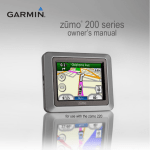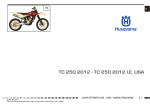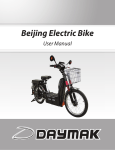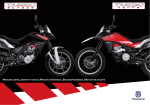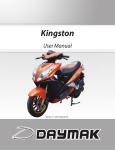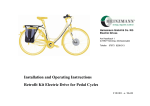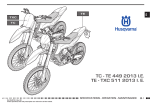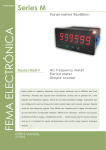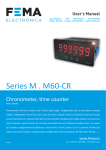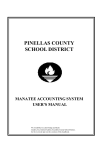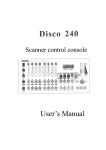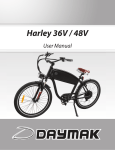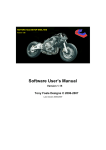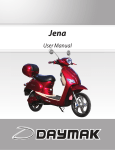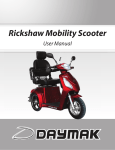Download NUDA 900 MY12 NUDA 900 R MY12
Transcript
EN
NUDA 900 MY12
NUDA 900 R MY12
SPECIFICATIONS - OPERATION - MAINTENANCE
Ed.01 - 11/2011
Unless specified, data and prescription are referred to all the models.
EN - 1
SUMMARY
Page
PRESENTATION.............................................................3
IMPORTANT NOTICES....................................................3
INTENDED USE..............................................................4
GENERAL RECOMMENDATIONS......................................4
IDENTIFICATION DATA...................................................6
TECHNICAL DATA...........................................................7
TABLE FOR LUBRICATION, SUPPLIES...............................8
MOTORCYCLE OVERALL VIEW ........................................9
CONTROLS..................................................................11
COMBINED DASHBOARD.............................................12
RIDING........................................................................19
SUSPENSION SETTINGS SUMMARY TABLES...................35
APPENDIX...................................................................46
PRE-DELIVERY INSPECTION..........................................48
ALPHABETICAL INDEX..................................................49
SCHEDULED MAINTENANCE........................... APPENDIX A
Note
lReferences to the “left” or “right” of the motorcycle
are considered from the point of view of a person facing forward.
lZ: number of teeth
lA: Austria
AUS: B: BR: CDN: CH: D: E: F: FIN: GB: I: J: USA: Australia
Belgium
Brazil
Canada
Switzerland
Germany
Spain
France
Finland
Great Britain
Italy
Japan
United States of America
lUnless otherwise specified, all the data and the instructions refer to all Countries.
EN - 2
SPECIFICATIONS - OPERATION - MAINTENANCE
IMPORTANT NOTICES
1) NUDA 900 models are designed for ROAD use,
guaranteed free from faults, and covered by legal warranty provided that NO CHANGE IS MADE TO THE STANDARD SETTING and that the intervals specified in maintenance table of Appendix A are complied with.
2) All the motorcycles and any of their
parts used in competitions of any type
are excluded from the warranty.
SPECIFICATIONS - OPERATION - MAINTENANCE
EN - 3
EN
PRESENTATION
Welcome to the Husqvarna motorcycling family!
Your new Husqvarna motorcycle is designed and manufactured to be the best in its field. The instructions in
this book have been prepared to provide a simple and
understandable guide for your motorcycle’s operation
and care. Follow the instructions carefully to obtain
maximum performance and your personal motorcycling
pleasure. Your owner’s manual contains instructions
for owner care and maintenance. The main repair or
maintenance work requires the attention of a skilled
mechanic and the use of special tools and equipment.
Your Husqvarna Dealer has the facilities, experience and
original parts necessary to properly render this valuable
service.
This “Owner’s Manual” is part and
parcel of the motorcycle, hence, it shall
remain with the motorcycle even when
sold to another user.
This motorcycle uses components designed thanks to
systems and state-of-the-art technologies which are
thereafter tested in competitions.
In racing motorcycles, every detail is verified after each
race in order to guarantee better performance at all
times.
To ensure trouble-free operation of the motorcycle, the
maintenance and inspection table found under Appendix A must be complied with.
IMPORTANT
In order to maintain the vehicle’s “Guarantee of Functionality”, the client must
follow the maintenance programme indicated in the user’s manual by carrying
out maintenance inspections at authorised HUSQVARNA dealers.
The cost for replacing parts and the labour required to comply with the maintenance plan is charged to the Client.
NOTE: the warranty is NULL AND VOID if
the motorcycle is rented.
WARNING*:
ALWAYS remember that all the motorcycles and their parts used in competitions of any type are excluded from the
warranty and that all modifications to
standard configuration cause THE VEHICLE NON COMPLIANCE WITH TYPE-APPROVAL REQUIREMENTS and it is hence
unsuitable for circulating on public
roads: consequently it may be used only
in “CLOSED CIRCUITS” by authorised subjects holding the relevant driving licence
or authorisation.
Important Notice
Read this manual carefully and pay special attention to
statements preceded by the following words:
EN - 4
WARNING*:
Indicates the possibility of severe personal injury or death if instructions are
not followed.
CAUTION*:
Indicates the possibility of personal injury or vehicle damage if instructions
are not followed.
Note*:
Gives helpful information.
Parts Replacement
When parts replacement is required, use only Husqvarna
ORIGINAL parts.
WARNING*: After a crash, inspect the
motorcycle carefully. Make sure that
the throttle control, brake, clutch and all
other systems are undamaged. Riding
with a damaged motorcycle can lead to
a serious accident.
WARNING*: Never attempt to start or
operate your motorcycle unless you are
wearing appropriate protective clothing. Always wear a motorcycle helmet,
boots, gloves, goggles and other appropriate protective clothing.
PRECAUTIONS FOR CHILDREN
WARNING*:
l Park the vehicle where it is unlikely
to be bumped into or damaged.
Even slight or involuntary bumps can
cause the vehicle to tip over, with sub-
SPECIFICATIONS - OPERATION - MAINTENANCE
sequent risk of serious harm to people or children.
l To prevent the vehicle from tipping
over, never park it on soft or uneven
ground, nor on asphalt strongly heated by the sun.
l Engine and exhaust pipes become
very hot during riding. Always park
your motorcycle where people or children can not easily reach these parts,
in order to avoid serious scalds.
l Do not leave the vehicle unattended
with the engine running or the key in
the ignition.
INTENDED USE
This motorcycle has been manufactured so as to withstand standard road stresses.
GENERAL RECOMMENDATIONS
Read these general recommendations carefully before
using the vehicle.
Carbon monoxide
Only run the engine in an open or very well ventilated
area. If you do work in an enclosed area, make sure
you use a fume extraction system.
WARNING*:
Exhaust emissions contain carbon monoxide, a poisonous gas which can cause
loss of consciousness and even death if
inhaled.
CAUTION*:
Risk of burns - work with caution and
wear suitable PPE if necessary.
Fuel
WARNING*:
The fuel used to power internal combustion engines is highly flammable
and explosive.
Refuel in ventilated areas with the
engine switched off; do not smoke
and avoid contact between the fuel
and naked flames, sparks, etc. that
may cause an explosion.
Do not dispose of fuel in the environment.
Keep out of reach of children.
CAUTION*:
Do not tilt the vehicle excessively since
this may cause fuel to leak.
Engine
In some cases, coolant may become inflammable and
if burnt, produce invisible flames which cause burns.
WARNING*:
Do not spill coolant onto hot components like the engine or exhaust pipe,
etc. since it may ignite.
During maintenance work, wear latex
gloves.
Never leave the coolant in open containers in areas accessible to children and
animals since it is toxic.
DO NOT remove the radiator cap when
the engine is hot; the coolant is pressurised and may cause scalding.
Engine oil
CAUTION*:
Do not dispose of oil in the environment
since it is highly polluting.
Keep out of reach of children.
Wear latex gloves since prolonged contact with the skin can cause serious
damage.
Send used oil to special authorised recyclers in accordance with the legal requirements in force in the country where
the vehicle will be used.
Brake fluid
WARNING*:
Brake fluid is highly corrosive and may
damage the rubber and painted parts of
the vehicle.
While performing maintenance work,
protect your eyes by wearing special
goggles and wear protective gloves.
In the event of accidental contact with
the eyes, rinse them with plenty of
clean, running water and seek medical
advice immediately.
Keep out of reach of children.
Battery
WARNING*:
Recharge the battery in well ventilated
areas since the battery produces toxic,
highly inflammable gases when being
recharged; do not smoke or use naked
flames or sparks.
The liquid in the battery is highly corrosive. If it comes into contact with the
skin, rinse thoroughly with running water. It is extremely important to protect
your eyes because even a small amount
of liquid can cause irreversible damage
to the eyes.
SPECIFICATIONS - OPERATION - MAINTENANCE
EN - 5
EN
Parts of the vehicle that become hot
Before working on the engine and the exhaust unit,
wait for them to cool down; while the vehicle is running, these parts become very hot and remain hot for
some time after turning off the engine.
If it comes into contact with the eyes,
rinse thoroughly with clean, running
water and if swallowed accidentally,
drink plenty of water or milk.
In all cases, seek medical advice immediately.
The battery liquid is corrosive and
should not be poured onto the painted
or rubber parts.
The battery liquid is highly polluting. DO
NOT dispose in the environment; at the
end of its service life, take the battery
to the special authorised recycling centres in accordance with the legal requirements in force in the country where the
vehicle will be used.
Keep out of reach of children.
IDENTIFICATION DATA
The engine identification number is stamped on the bottom RH side of the crankcase whereas the motorcycle serial number is stamped on the steering tube.
Always quote the number stamped on the
frame when ordering spare parts or requesting further
details about your vehicle and note it on this booklet.
CHASSIS NUMBER
Vehicle identification number (V.I.N.)
The full 17-digit serial, or Vehicle Identification Number, is
stamped on the steering tube (R.H. side).
(l) = Model designation
(▲) = Model Year (2012)
(♦) = Progressive no.
2
NUDA 900
ZKHA700A#CV000001
(l) (▲)
(♦)
NUDA 900 R
ZKHA700B#CV000001
(l)
EN - 6
1
SPECIFICATIONS - OPERATION - MAINTENANCE
(▲)
(♦)
1. Chassis serial number
2. Engine serial number
ENGINE
Inline twin cylinder, 4 stroke, with four valves per cylinder
Cooling. . . . . . . . . . . . . . . . . . . . . liquid and electric fan
Bore. . . . . . . . . . . . . . . . . . . . . . . . . . 3,31 in. (84 mm)
Stroke. . . . . . . . . . . . . . . . . . . . . . . . . 3,19 in. (81 mm)
Displacement . . . . . . . . . . . . . . . . . . 54,8 in3 (898 cm3)
Compression ratio . . . . . . . . . . . . . . . . . . . . . . . . . 13:1
Starting . . . . . . . . . . . . . . . . . . . . . . . . . . . . . . . electric
Type of fuel. . . . . . . . . . . . . . unleaded fuel 95ROZ/RON
TIMING SYSTEM
Type. . . . . . . double overhead camshaft chain operated;
4 valves per cylinder
Valve clearance (with engine cold)
Intake. . . . . . . . . 0,0091 ÷ 0,013 in. (0.23 ÷ 0.33 mm)
Exhaust. . . . . . . 0,0118 ÷ 0,0161 in. (0.30 ÷ 0.41 mm)
LUBRICATION
Type. . . . . . . . . . . dry sump oil circuit with built-in tank,
cartridge filter and oil/water heat exchanger
IGNITION
Type. . . . . . . . . . . . . . . . . . . . Electronic with adjustable
advance (digital control)
Spark plug type . . . . . . . . . . . . . . . . . “NGK” LMAR8C-9
Spark plug electrode gap
. . . . . . . . . . . 0,0315 ÷ 0,0354 in. (0.8 ÷ 0.9 mm)
FUEL SYSTEM
Type. . . . . . . . . . . . . . . . . . . . . Electronic injection feed
PRIMARY DRIVE
Drive gear on crankshaft. . . . . . . . . . . . . . . . . . . . . Z 35
Driven gear on clutch housing. . . . . . . . . . . . . . . . . Z 68
Transmission ratio . . . . . . . . . . . . . . . . . . . . . . . . 1.943
CLUTCH
Type. . . oil bath multiple disc clutch, mechanical control
TRANSMISSION
Type. . . . . . . . . . . . . . . . . . . . constant mesh gear type
Transmission ratio
1st gear . . . . . . . . . . . . . . . . . . . . . . . . . 2.462 (32/13)
2nd gear. . . . . . . . . . . . . . . . . . . . . . . . . 1.750 (28/16)
3rd gear. . . . . . . . . . . . . . . . . . . . . . . . . 1.381 (29/21)
4th gear. . . . . . . . . . . . . . . . . . . . . . . . . 1.174 (27/23)
5th gear. . . . . . . . . . . . . . . . . . . . . . . . . 1.042 (25/24)
6th gear. . . . . . . . . . . . . . . . . . . . . . . . . 0.960 (24/25)
SECONDARY DRIVE
Transmission sprocket (NUDA 900) . . . . . . . . . . . . . Z 17
Transmission sprocket (NUDA 900 R). . . . . . . . . . . . Z 16
Rear wheel sprocket. . . . . . . . . . . . . . . . . . . . . . . . Z 42
Transmission ratio (NUDA 900). . . . . . . . . . . . . . . . 2.47
Transmission ratio (NUDA 900 R) . . . . . . . . . . . . . 2.625
Transmission chain dimensions. . . 5/8” x 5/16” (525)
FINAL RATIOS
NUDA 900
1st gear . . . . . . . . . . . . . . . . . . . . . . . . . . . . . . . 11,815
2nd gear. . . . . . . . . . . . . . . . . . . . . . . . . . . . . . . . 8,398
3rd gear. . . . . . . . . . . . . . . . . . . . . . . . . . . . . . . . 6,627
4th gear. . . . . . . . . . . . . . . . . . . . . . . . . . . . . . . . 5,634
5th gear. . . . . . . . . . . . . . . . . . . . . . . . . . . . . . . . 5,000
6th gear. . . . . . . . . . . . . . . . . . . . . . . . . . . . . . . . 4,607
NUDA 900 R
1st gear . . . . . . . . . . . . . . . . . . . . . . . . . . . . . . . 12,557
2nd gear. . . . . . . . . . . . . . . . . . . . . . . . . . . . . . . . 8,925
3rd gear. . . . . . . . . . . . . . . . . . . . . . . . . . . . . . . . 7,043
4th gear. . . . . . . . . . . . . . . . . . . . . . . . . . . . . . . . 5,987
5th gear. . . . . . . . . . . . . . . . . . . . . . . . . . . . . . . . 5,314
6th gear. . . . . . . . . . . . . . . . . . . . . . . . . . . . . . . . 4,896
CHASSIS
Type . . . . tubular steel trellis with removable steel rear
chassis.
FRONT SUSPENSION
NUDA 900
Type upside-down hydraulic fork
. . . . . . . . . . . . . . . . . . ø 1,89 in. (ø 48 mm) legs
Wheel travel. . . . . . . . . . . . . . . . . . . 8,27 in. (210 mm)
NUDA 900 R
Type upside-down hydraulic fork (adjustable compression, rebound and spring reload) . . . . . . . . . . . . . . . . . . . ø 1,89 in. (ø 48 mm) legs
Wheel travel. . . . . . . . . . . . . . . . . . . 8,27 in. (210 mm)
REAR SUSPENSION
NUDA 900
Type. . . . . . . . . . . . . . . direct with hydraulic monoshock
(adjustable spring preload and hydraulic rebound damping)
Wheel travel. . . . . . . . . . . . . . . . . . . 7,09 in. (180 mm)
NUDA 900 R
Type. . . . . direct with hydraulic monoshock (adjustable
spring preload and hydraulic compression and rebound
damping; adjustable length)
Wheel travel. . . . . . . . . . . . . . . . . . . 7,09 in. (180 mm)
SPECIFICATIONS - OPERATION - MAINTENANCE
EN - 7
EN
TECHNICAL DATA
FRONT BRAKE
Type . . . . . . . . twin floating disc ø 12,6 in. (ø 320 mm)
with radial pump and radial callipers
REAR BRAKE
Type. . . . . . . . . . . . . fixed disc ø 10,43 in. (ø 265 mm)
and floating calliper
RIMS
Front. . . . . . . . . . . . . . . . . . . . . in light alloy: 3.5”x17”
Rear. . . . . . . . . . . . . . . . . . . . . in light alloy: 5.5”x17”
TYRES
Front. . . . . . . . . . . . . . . . . . . . . . . . . . . 120/70xZR17”
Rear. . . . . . . . . . . . . . . . . . . . . . . . . . . 180/55xZR17”
Cold tyre pressure
Front. . . . . . . . . . . . . . . . . . . . . 32,71 psi (2.3 kg/cm2)
Rear. . . . . . . . . . . . . . . . . . . . . 35,55 psi (2.5 kg/cm2)
DIMENSION, WEIGHT, CAPACITY
Wheelbase . . . . . . . . . . . . . . . . . . 58,86 in. (1495 mm)
Overall length. . . . . . . . . . . . . . . . 86,22 in. (2190 mm)
Overall width . . . . . . . . . . . . . . . . . 35,16 in. (893 mm)
Max. height . . . . . . . . . . . . . . . . . 48,03 in. (1220 mm)
Seat height (NUDA 900) . . . . . . . . . 34,25 in. (870 mm)
Seat height (NUDA 900 R) . . . . . . . . . 34,45 ÷ 35,04 in.
(mm 875 ÷ 890)
Min. ground clearance. . . . . . . . . . . . 7,68 in. (195 mm)
Coolant tank capacity. . . . . . . . . . . . . . . 0,31 Imp. Gall.
0,37 U.S. Gall.
1.4 l
Transmission oil
Oil and oil filter replacement. . . . . . . . . . 0,73 imp. Gall.
0,87 U.S. Gall.
3.3 l
Oil replacement. . . . . . . . . . . . . . . . . . . . . 0,7 Imp. Gall.
0,85 U.S. Gall.
3.2 l
Oil top up between minimum and maximum
level. . . . . . . . . . . . . . . . . . . . . . . . . . . . . 0,09 Imp. Gall
0,11 U.S. Gall.
0.4 l
TABLE FOR LUBRICATION, SUPPLIES
Engine, gearbox and primary drive lubricating oil
1) CASTROL POWER1 RACING SAE 5W-40
2) SAE rating: 15W-40 API: SG/SH JASO: MA
Engine coolant . . . . . . . . . CASTROL MOTORCYCLE COOLANT
Brake fluid . . . . . . . . . . CASTROL RESPONSE SUPER DOT 4
Grease lubrication. . . . . . . . . . . . . . CASTROL LM GREASE 2
Secondary drive chain lubrication
. . . . . . . . . . . . . . . . . . . . CASTROL CHAIN LUBE RACING
Electric contact protection
. . . . . . . . . . . . . . CASTROL METAL PARTS CLEANER
Kerb weight, without fuel.. . . . . . . . 407,85 lb (185 kg)
Dry weight . . . . . . . . . . . . . . . . . . . . 383,6 lb. (174 kg)
Fuel tank capacity reserve included . . . . 2,86 Imp. Gall
3,43 U.S. Gall.
13 l
Fuel reserve . . . . . . . . . . . . . . . approx. 0,66 Imp. Gall.
approx. 0,79 U.S. Gall.
approx. 3 l
EN - 8
SPECIFICATIONS - OPERATION - MAINTENANCE
LEGEND
1. 2. 3.
4. 5. 6. 7. Front wheel
Left-hand front brake disc
Right-hand front brake disc
Left-hand front brake calliper
Right-hand front brake calliper
Front fork
Gear shift pedal (the first gear is engaged by
pushing lever downwards; for other gears push
it upwards. The neutral gear is between the first
and second gear)
8. Side stand
9. Rear sprocket
10. Rear wheel
11. Number plate holder
12. Rear turning indicators
13. Tail light
14. Saddle
15.Rear-view mirrors
16. Front turning indicators
17. Headlight
18. Rear brake control pedal
19. Rear brake master cylinder
20. Front sprocket
21. Rear brake disc
22. Rear brake calliper
23. Passenger footrests
24.Passenger grab handles
25. Silencer
26. Radiator
27. Oil filter
28. Allen wrench for saddle removal
9
22
28
15
14
13
24
16
20
21
12
17
11
6
19
18
25
26
5
4
3
8
23
1
2
10
27
N
4
3
2
1
5
6
7
SPECIFICATIONS - OPERATION - MAINTENANCE
EN - 9
EN
MOTORCYCLE OVERALL VIEW
29. Fuel tank filler cap
30. Digital dashboard
31. Ignition switch
32. Right-hand switch
33. ENGINE STOP button (emergency stop)
34. Engine start button
35. Front brake control lever
36. Throttle twistgrip
37. Clutch control lever
38. Left-hand switch
32
30
36
33
31
35
34
37
29
EN - 10 SPECIFICATIONS - OPERATION - MAINTENANCE
38
CONTROLS
CAUTION*:
1
WARNING*:
The stand is designed to support the
WEIGHT of the MOTORCYCLE ONLY. Do
not sit astride the motorcycle using the
stand for support as this could cause
structural failure to the stand resulting
in serious injury.
3
Using leaded fuel causes permanent
damage to the catalytic converter
which loses its effectiveness.
WARNING*:
Fuel is extremely flammable and can be
explosive under certain conditions. Always stop the engine and do not smoke
or allow flames or sparks in the area
where the motorcycle is refuelled or
fuel is stored.
WARNING*:
Do not overfill the tank. Refer to the
lower mark on filler. After refuelling,
make sure the tank cap (3) is closed securely.
A side stand (1) is supplied with every motorcycle. To
lower it, put your foot on the lever (2).
4
WARNING*:
The stand does NOT have automatic retraction.
The stand has a rotary type switch that
turns off the engine if a gear is engaged
when the stand is lowered.
Periodically check the side stand (see “Scheduled Maintenance Chart”); make sure that the springs are not damaged and the side stand freely moves. If the side stand is
noisy, lubricate the fastening pivot (A).
- Lift the flap (1), insert the key (2), turn it counterclockwise and remove the tank cap (3).
- Fully insert the fuel pump nozzle (4) in the tank
before refuelling (see figure).
- After refuelling, replace the cap (3) turning it the
opposite way from when it was removed.
A
2
1
SPECIFICATIONS - OPERATION - MAINTENANCE EN - 11
EN
REFUELLING
Use
UNLEADED petrol with octane rating of 95 or
higher only.
SIDE STAND
2
COMBINED DASHBOARD
The motorcycle has a combined dashboard divided into
the following areas:
1. Warning lights (see “Description of warning
lights”).
2. Multifunction display (see “ Description of multifunction display”).
3. Rev meter
Indicates the engine rpm.
4. Alarm system warning light (RED).
5. Overrev warning lights (RED)
When 8500 rpm is reached, warning light (5a)
comes on. When 9000 rpm is reached, warning
light (5a) stays on together with warning light
(5b)
6. Engaged gear display
This indicates the engaged gear; neutral is indicated with this symbol “ ”.
7. “MODE” button
Vehicle performance can be varied by selecting
“RAIN” mapping.
The ECU memorises two different mappings that
can be selected using the “MODE” button (see
specific section).
The standard configuration delivers maximum
engine power. The second mapping delivers
power than can be used more at low and medium revs and is suitable when using the vehicle
on wet roads or low grip situations (see “Map
change”).
4
1
3
2
7
8
5a
9
8. “SET” button
This displays the various functions of the multifunction display (see “Description of multifunction display”).
9. "HAZARD" button
When this is pressed, the turning indicators,
and warning light
flash
warning light
at the same time.
Press it again to deactivate the hazard warning
lights.
EN - 12 SPECIFICATIONS - OPERATION - MAINTENANCE
6
5b
5
ABS
“ABS” warning light (not used).
Turning indicator warning light (GREEN)
This flashes when the turning indicators have
been turned on or the “HAZARD” button has
been pressed.
High beam warning light (BLUE)
This lights up permanently when the high beam
is on.
High coolant temperature warning light (RED).
This lights up permanently when the coolant
reaches the alarm temperature;
Slow down until you come to a stop, let the
engine idle and wait for the temperature to
decrease (scale shown on display) and the
warning light to go out.
If the problem persists, check the coolant level
in the expansion tank. If the liquid level is correct, contact your HUSQVARNA dealer.
to have the fault checked.
“HAZARD” warning light (RED)
This flashes together with the warning light
and the turning indicators when switch
has been pressed.
Fuel reserve warning light (ORANGE)
This comes on when there are approximately 3
litres of fuel left in the tank.
You need to refuel.
Note *:
the fuel light normally switch off a few time after
the fuel refilling operation.
Description of multifunction display
1
3
2
4
Neutral warning light (GREEN)
This lights up permanently when the motorcycle is in neutral.
Engine diagnosis warning light (ORANGE)
This lights up permanently when the engine
ECU has diagnosed malfunctioning.
There are two types of fault:
- Critical fault: the engine switches off and
you must contact your HUSQVARNA dealer.
- Fault with emergency operating: the engine
operates with reduced performance to allow
you to reach the nearest HUSQVARNA dealer
1. "ICE" indicator:
This appears when the external temperature is
lower than 3°C or 37.4°F
2. “SERVICE” indicator:
This indicates that it is time for a service.
Contact your HUSQVARNA dealer to have scheduled maintenance work carried out.
3. “MAP II” indicator:
This appears when “RAIN” mapping is selected
4. km/h or mp/h odometer scale indicator (see
“setting units of measurement”)
5. Speed indicator.
6. Display parameters:
This field is used to individually set the parameters below that will be displayed in (7).
ODO = Odometer / Total mileage
TRIP = Odometer / Partial mileage
(to set the functions, see “Setting parameters”)
TEMP = Air temperature (AIR BOX) / Coolant
temperature
CON = Actual fuel consumption / Average consumption.
CLOCK = Clock ( see “Clock adjustment”).
7. This displays the parameter set in (6).
8. This lights up in sequence from left to right as the
coolant temperature increases.
5
6
8
7
SPECIFICATIONS - OPERATION - MAINTENANCE EN - 13
EN
Description of warning lights
Clock adjustment
The clock must be set when the motorcycle is stationary
and the key is set to ON.
The clock is set to 24 hours.
- Press the “S” button (1) until the word “CLOCK” appears on the display.
is automatically memorised after 10 seconds.
Setting units of measurement
> 4”
The units of measurement must be set when the motorcycle is stationary and the key is set to ON.
- Press the “S” button (1) until the word “ODO” or
“TEMP” appears on the display.
> 4”
1
- Press the “S” button for more than 4 seconds and the
hours will flash on the display.
- The value of the hours increases by one unit each time
you press the “S” button.
- The value of the hours decreases by one unit each time
you press the “M” button.
> 4”
4”<
- Press the “S” button for more than 4 seconds to memorise the hours set and the minutes will flash on the
display.
- The value of the minutes increases by one unit each
time you press the “S” button.
- The value of the minutes decreases by one unit each
time you press the “M” button.
- To memorise the time once you have set it, press the
“S” button for more than 4 seconds. If not, the setting
1
- Press the “S” button for more than 4 seconds. The word
“SET” appears on the display and the unit of measurement currently in use flashes.
- Press the “S” button once to change the unit of measurement. Once you have selected the unit of measurement, press the “S” button” for more than 4 seconds to
confirm the set data and go onto the next scale.
The following units of measurement can be set:
Km / mp = the display will show:
- the speed in “km/h” or “mp/h” ;
- the total distance covered in “km” or “mp”
- the partial “TRIP” distance covered in “km” or “mp”.
Temperature = °C / °F
Quantity of fuel:
L = (litres) - UG = US/GAL - IG = IM/GAL
- To quit the “SET” stage once you have made your last
setting, press the “S” button for more than 4 seconds. If
not, the program automatically quits after 10 seconds.
EN - 14 SPECIFICATIONS - OPERATION - MAINTENANCE
> 4”
With the dashboard on, press the “S” button (1) to display the various display functions:
ODO ; TRIP ; TEMP ; CON ; CLOCK
1
The “ODO”, “TEMP” and “CLOCK” functions are for display purposes only.
TRIP function:
When this function is activated, press the “S” button for
more than 4 seconds to reset and start a new partial
count of the kilometres /miles subsequently travelled.
When this function is set after the fuel reserve light has
come on, press the “S” button “S” (1) for more than 4
seconds to display fuel consumption (in litres or gallons
depending on the unit of measurement you have selected) from when you go onto fuel reserve.
1
CON function:
When this function is activated, press the “S” button for
more than 4 seconds to reset and start a new count of the
litres/ gallons consumed from when average consumption (L/100 km) has been reset.
Changing ECU mapping:
The vehicle leaves the factory in “STANDARD” configuration, i.e, with maximum power.
Motorcycle performance can be changed from “STANDARD” to “RAIN” by pressing the “M” button (1) on the
dashboard.
The map can be changed when the vehicle is moving
(key turned to “ON”) or stationary.
Press the “M” button for more than 3 seconds:
if the vehicle is moving, “MAP II” flashes intermittently
on the display and the “RAIN” configuration is activated
as soon as the accelerator is completely closed (“MAP II”
permanently lit on the display) whereas if the vehicle is
stationary, “MAP II” appears permanently lit after pressing the “M” button for more than 3 seconds.
To go from “RAIN” to “STANDARD” mapping, proceed in
the same way.
In “STANDARD” mode, there is no indication on the display.
When the vehicle is off (key turned to “OFF”) the current
mapping is always maintained.
1
SPECIFICATIONS - OPERATION - MAINTENANCE EN - 15
EN
Setting parameters
THROTTLE CONTROL
The throttle twistgrip (1) is located on the right-hand side
of the handlebar. The position of the control on the handlebar can be adjusted by loosening the two retaining
screws (2).
FRONT BRAKE CONTROL
IGNITION SWITCH
CAUTION*:
Do not forget to tighten the screws (2)
after adjusting.
WARNING*:
After adjustment, turn the handlebar as
far as possible to the right and make
sure that the lever does not touch the
bodywork.
The brake control lever (1) is located on the right-hand
side of the handlebar. The position of the control on the
handlebar can be adjusted by loosening the two retaining screws (2).
A stop switch, during the braking action, causes the stop
light on the tail light to come on.
CAUTION*:
Do not forget to tighten the screws (2)
after adjusting.
The ignition switch has three positions:
"OFF" position:
Key removal and engine stop positions
"ON" position:
From the OFF position, turn the key (1) counterclockwise
to the ON position; the ignition, parking lights and utilities are activated and the engine can be started;
“ ” position:
Steering lock position (see steering lock)
1
2
OFF
PU
SH
ON
1
2
2
1
EN - 16 SPECIFICATIONS - OPERATION - MAINTENANCE
RIGHT-HAND HANDLEBAR SWITCH
The motorcycle has a steering lock on the ignition.
The right-hand switch features the following controls:
1) Engine start button
2) Engine KILL SWITCH.
To lock it, proceed as follows:
- Turn the handlebar as far as possible to the left .
- Insert the key in the ignition (1), press the key
down, turn it from the “OFF” position to the “ ”
position and then remove it.
- To unlock the steering, follow the steps for locking in
reverse order.
EN
STEERING LOCK
2
1
1
L.H. HANDLEBAR SWITCH
The left-hand handlebar switch contains the following
commands:
High beam flasher (self-cancelling).
1)
OFF
PU
SH
ON
2)
High beam switch.
Low beam switch.
3)
Left-hand turning indicators.
Right-hand turning indicators .
To deactivate the turning indicators, press the control
lever after it is returned to the centre.
1
4)
Horn.
2
4
3
SPECIFICATIONS - OPERATION - MAINTENANCE EN - 17
CLUTCH CONTROL
The clutch control lever (1) is located on the left-hand
side of the handlebar.
The position of the clutch control on the handlebar can be
adjusted by loosening the retaining screws (2).
REAR BRAKE CONTROL
WARNING*:
After adjustment, turn the handlebar
as far as possible to the left and make
sure that the lever does not touch the
bodywork.
A stop switch, during the braking action, causes the stop
light on the tail light to come on.
The rear brake control (1) is placed on the right-hand
side of the motorcycle.
GEAR SHIFT CONTROL
The lever (1) is placed on the left-hand side of the engine. The operator must release the lever after each gear
change to allow it to return to its central position. Neutral
position (N) is between the first and second gears.
First gear is engaged by pushing the lever downwards;
for other gears push it upwards.
The position of the gear shift lever (1) on the shaft can be
varied. To do this, loosen the screw (2), pull the lever out
and place the lever in a new position on the shaft.
Tighten the screw once operation is completed.
WARNING*: Do not push the lever too
far down!
CAUTION*: Do not shift gears without
disengaging the clutch and closing the
throttle. The engine could be damaged
by overspeed.
A "STOP" switch on the clutch lever support allows you
to start the engine when the motorcycle is in gear or the
clutch lever is pulled (the stand must be off the ground).
CAUTION*:
Do not forget to tighten the screws (2)
after adjusting.
WARNING*: Do not downshift when
travelling at a speed that would force
the engine to overrev in the next lower
gear, or cause the rear wheel to lose
grip.
1
2
N
1
EN - 18 SPECIFICATIONS - OPERATION - MAINTENANCE
2
1
NOTE*: If you are not familiar with operating a motorcycle, read the instructions in the “CONTROLS” section before
riding this motorcycle.
PRE-RIDE CHECKS
Any time you ride your motorcycle, make a general inspection first and proceed to check the following:
- check fuel level and engine oil level;
- check brake fluid level;
- check the steering by turning the handlebar both ways,
fully home;
- check the tyre pressure;
- check the chain tension;
- check the throttle control and adjust it, if necessary;
- turn the ignition switch to ON position: check dashboard
display lighting;
- check that parking lights, low beam and high beam
come on, as well as the relevant warning light;
- operate the turning indicators and check that the warning light comes on;
- check if the rear stop light is functioning.
Optimum performance during acceleration is only obtained after the first 1000
km (625 mi) of running in.
Follow these guidelines:
do not fully open the throttle grip abruptly at low engine
speeds, either during or after the running in period.
During the first 100 Km (62 miles) use the brakes gently,
avoiding sudden or prolonged braking.
This allows the brake pad friction material to bed in correctly with the brake discs.
During the first 1000 km (625 miles), never exceed 7000
rpm (see table).
After the first 1000 km (625 mi), have
the checks indicated in the Scheduled
Maintenance Chart performed to avoid
causing injury to yourself or others and
/or damage to the vehicle.
After 1000 km (625 miles) you can expect better engine
performance but without exceeding the maximum rpm
allowed (9000 rpm).
Recommended maximum engine rpm:
km (mi) covered
rpm
0-1000 (0-625)......................................................7000
over 1000 (625)....................................................9000
Running the engine in correctly is essential for ensuring
engine longevity and functionality.
Bendy roads and gradients are ideal for running in the
engine, brakes and suspension effectively.
Vary your riding speed during the running in period.
This ensures that components operate in "loaded" conditions and then "unloaded" conditions, allowing the
engine components to cool.
Although it is important to stretch engine components
during run-in, make sure you do not overdo it.
SPECIFICATIONS - OPERATION - MAINTENANCE EN - 19
EN
INSTRUCTIONS FOR USING THE MOTORCYCLE
TROUBLESHOOTING
The following list is used for troubleshooting and to find
the necessary remedies.
In any case, contact your authorised Husqvarna dealer
who has the experience and expertise required to provide
you with all the assistance you need.
The engine does not start.
- the starting procedures are not correctly followed: follow the instructions given in the section “Starting the
engine”.
- Stand down: raise the stand.
- No fuel: refuel.
- Flat / faulty battery: check/charge the battery.
- Faulty starter motor: repair or replace.
- Faulty start button: replace the switch.
The engine has starting problems.
- Dirty or worn out spark plug: clean or replace.
- Flat battery: charge.
The engine overheats.
- Obstructions to air flow on radiator: clean.
- Cooling fan does not start up: check/replace thermal
switch.
- Faulty fan: replace.
- Insufficient amount of fluid in radiator: top up.
- insufficient quantity of oil: top up.
The engine knocks.
- Excessive carbon deposit on the piston crown, or in the
combustion chamber: clean.
- Faulty spark plug or wrong heat rating: replace.
The alternator fails to charge or its charge is insufficient.
- The cables on the voltage regulator are badly connected, or in short-circuit: connect correctly or replace.
- Faulty alternator coil: replace.
- Demagnetised alternator rotor: replace.
- Faulty voltage regulator: replace.
The battery overheats.
- Faulty voltage regulator: replace.
Difficulty in shifting gears.
- Clutch not regulated correctly: regulate clutch.
The clutch slips.
- Insufficient spring load: replace.
- Worn-out clutch plates: replace.
Faulty brakes.
- Worn-out pads: replace.
- Air in the system: bleed.
- Low oil level: top up.
The engine lacks power.
- Dirty air filter: clean.
- Change the spark plug.
- Incorrect valve clearance: adjust.
- Insufficient compression: identify cause.
- Throttle body not regulated correctly: adjust.
EN - 20 SPECIFICATIONS - OPERATION - MAINTENANCE
General
Read the following section carefully since it provides important information on the rider's and passenger's safety
and avoids causing damage to the motorcycle.
The motorcycle must always be mounted or dismounted
from the left-hand side with your hands free, no obstacles
in the way and with the stand down.
The rider must be the first to get on and the last to get
off the motorcycle and must control the stability of the
motorcycle while the passengers mounts and dismounts.
- Start the motorcycle as described in the relevant section.
- Using your left leg, fully retract the stand.
Mounting of passenger
Get the rider to mount first as described in the relevant
section without starting the engine.
- Get the passenger to put the passenger footrests (1)
down
CAUTION*:
When in a riding position, the rider must
not pull out or attempt to pull out the
rear passenger footrests since this may
unbalance the vehicle.
Do not get off the vehicle by jumping or extending your
legs and always dismount by following the instructions
given in the relevant section.
Mounting of rider
With the motorcycle on the side stand, do the following:
- From the left side, hold the handlebar correctly with
both hands and extend your right leg over the saddle.
- Sit on the motorcycle and place both feet on the ground.
Balance the vehicle without putting all your weight on
the side stand.
CAUTION*:
If you are unable to place both feet on
the ground, put your right leg down
with your left leg poised.
1
SPECIFICATIONS - OPERATION - MAINTENANCE EN - 21
EN
MOUNTING/DISMOUNTING OF RIDER AND PASSENGER
Dismounting the motorcycle
- Stop the vehicle and switch off the engine.
Place your left hand on the rider's shoulder, your left
foot on the footrest and then mount the motorcycle by
lifting your right leg and moving carefully to avoid
unbalancing the vehicle and the rider.
- Hold onto the special handles (2).
CAUTION*:
Make sure that the area where you
want to park the vehicle is stable and
level.
- Start the motorcycle as described in the relevant section
- Using your left leg, fully retract the stand.
- Place both feet on the ground.
- Using your left leg, fully extend the stand.
- Get the passenger to dismount first from the left-hand
side of the vehicle by placing their foot on the left-hand
footrest and raising their right leg.
- Tilt the motorcycle to the left until it rests on the stand.
- Switch off the motorcycle as described in the relevant
section
- Firmly grasp the handlebar and dismount on the lefthand side by lifting your right leg.
2
EN - 22 SPECIFICATIONS - OPERATION - MAINTENANCE
STARTING THE ENGINE
OFF
Note*:
A safety switch is mounted on the clutch lever support
that allows you to start the engine ONLY when the gearbox is in neutral or when the gear is engaged and the
clutch lever pulled.
There is a switch on the side stand that turns off the engine when the clutch is released with the gear engaged
and the side stand lowered.
IMPORTANT
NEVER START ENGINE WITH BATTERY DISCONNECTED FROM CIRCUIT.
EN
PU
SH
ON
1)Turn key (1) in the ignition switch to ON (the hum
you may hear when key is turned to ON is caused
by the fuel pump pressurising the delivery system),
and wait until the dashboard CHECK has finished;
2) pull clutch lever (2);
3) shift gear pedal (3) to neutral;
4)check that the throttle control (4) is fully closed.
Note*:
The engine control unit has a startup strategy that only works if the
throttle control is fully closed.
5) Check that button (5) is in the out position and then
press the start button (6).
6)Release the clutch lever (2).
N
3
1
2
4
IMPORTANT NOTE IN CASE OF COLD START AT LOW TEMPERATURES
5
We recommend idling for a short time to warm up the
engine.
This allows oil to reach all points that need lubricating
and coolant to warm up to regular operating temperature.
Avoid warming up the engine for too long.
6
SPECIFICATIONS - OPERATION - MAINTENANCE EN - 23
RIDING YOUR MOTORCYCLE
WARNING*:
Before setting off make sure that:
- the side stand is fully up;
- the rear footrests are closed if there
is no passenger;
- the passenger knows what to do
while riding to avoid problems when
manoeuvring.
Note*:
The ECU memorises two different mappings ("Standard" and "Rain") that can be selected using the special
button on the dashboard (for map changing, see the section "Map change").
The "Standard" mapping delivers full power.
The "Rain" mapping delivers power than can be used
more at low and medium revs and is suitable when using
the vehicle on wet roads or low grip situations.
1)Start the motorcycle as described in the relevant
section.
2)Adjust the rear-view mirrors to the riding position to
ensure correct visibility.
3)With the throttle (1) closed and the engine idling,
pull the clutch lever (2) and push the gear lever (3)
down to select the first gear.
4)Slowly release the clutch lever (2) and, at the same
time, slightly accelerate by turning the throttle
twistgrip (1);
the vehicle will start to move.
1
Note*:
Select the best gear for the desired speed; speed changes
in proportion with turning the throttle. Therefore, turn
the throttle gradually without exceeding the recommended number of revs.
5)To go to the higher gears, do the following:
Release the throttle (1), pull the clutch lever (2),
lift the gear lever (3), release the clutch lever (2)
and accelerate at the same time.
2
Note*:
The engaged gear is displayed on the dashboard.
WARNING*:
Vehicles seen in the rear-view mirrors
appear to be further away than they
really are due to the special shape
of the rear-view mirrors; get familiar
with using your mirrors to ensure correct and safe riding.
EN - 24 SPECIFICATIONS - OPERATION - MAINTENANCE
N
4
3
2
1
5
6
3
1
Here are some basic principles for riding your motorcycle safely.
- Remember that your safety and the safety of your
passenger come first. Reaching your destination
safely must be your main aim.
- The rider and passenger must wear suitable protective clothing including overalls, gloves, shoes and a
helmet suitable for motorcyling.
- The rider must be seated on the motorcycle in a position that gives the best possible visibility of the road
ahead.
- Ride the motorcycle carefully and set the speed according to traffic and the type of road.
Smooth riding helps you to assess danger and enter
bends more precisely.
- Always observe road signs and adjust your speed accordingly.
- Always observe speed limits.
- Always assess the road conditions and adjust your
speed accordingly.
- Reduce speed if it is raining and especially if there
are puddles of water on the road.
- When riding on wet or low grip surfaces (snow, ice,
mud, etc.) keep a moderate speed and avoid sudden
braking and manoeuvres.
- Keep a safe distance from the vehicles in front of
you.
- Before overtaking, check there are no obstacles in
front of the vehicle you want to overtake and always
check in the rear-view mirrors that there are no vehicles coming up from behind.
- Brake using both the front and the rear brake at the
same time: this helps to maintain the stability of the
vehicle.
- Release the clutch gradually when downshifting.
- If you feel tired or sleepy, take a break.
- Downshift in the following instances:
When going downhill and when braking to increase
the braking action through engine compression; using only brakes when going downhill could cause
the brake pads to overheat and reduce the braking
action;
When going uphill or on the flat when the gear does
not match the speed of the motorcycle (high gear
and low speed);
WARNING*:
Downshift one gear at a time; downshifting more than one gear at a
time may cause the engine to overrev and/or block the rear wheel.
- Do not switch off the engine when going downhill.
- When you ride with a passenger, increase the distance from the vehicles in front of you and bar in
mind your weight when you brake and when you
have to round a bend or overtake.
- Do not use straps, cords, etc. to fasten luggage. Only
use approved panniers suitable for the type of motorcycle you are using.
SPECIFICATIONS - OPERATION - MAINTENANCE EN - 25
EN
SAFE RIDING
- To stop the engine, turn key (6) to OFF (key removal
position).
STOPPING THE MOTORCYCLE AND THE ENGINE
- Close the throttle (1) completely so that the engine
will help slow down the motorcycle.
- Apply both front (2) and rear (3) brakes while downshifting (for fast deceleration, press firmly on the
front brake lever and the rear brake pedal simultaneously).
- Pull the clutch lever (4), put the gear lever (5) into
neutral and then stop the motorcycle completely.
OFF
PU
SH
ON
3
6
WARNING*:
Independent use of the front or rear
brake may be advantageous under certain conditions. Be careful when using
the front brake, especially on slippery
surfaces. Improper use of the brakes
can lead to a serious crash.
4
2
N
1
EN - 26 SPECIFICATIONS - OPERATION - MAINTENANCE
5
CATALYTIC CONVERTER
OIL LEVEL CHECK
- In an “EMERGENCY” press the red button (1) to stop
the engine.
- This motorcycle has an exhaust system with a
catalytic converter; this oxidises the exhaust fumes
(carbon monoxide and unburned hydrocarbons)
and converts them into carbon dioxide and water
vapour.
- Start vehicle as described in the relevant section, let it
run for approx. 3 minutes so as to warm engine up.
- Stop the engine.
- Keeping the motorbike upright and on even ground,
CAUTION*:
The catalytic converter reaches very high
temperatures while the motorcycle is in
use. You should therefore avoid parking the motorcycle on dry grass because
there is a risk it will catch fire.
WARNING*:
In the event of stuck throttle or other malfunction which causes the engine to run
uncontrollably, IMMEDIATELY depress the
engine kill switch (7). Control the motorcycle by normal use of the brakes and steering while pressing the engine kill switch.
- Make sure there are no signs of rust or holes in the
exhaust system and that the exhaust system works
correctly; if the noise generated by the exhaust system increases significantly, contact an authorised
HUSQVARNA Dealer.
1
MAX
MIN
MIN
WARNING*:
Only use this button in an “EMERGENCY” and use it with extreme caution especially if the motorcycle is moving at
speed.
CAUTION*:
Do not tamper with and/or remove the
catalytic converter or its components;
removal of these components leads to
VEHICLE NON COMPLIANCE WITH TYPEAPPROVAL REQUIREMENTS making it unsuitable for use on public roads.
wait a few minutes for the oil to reach the sump.
- Check the level as follows:
- Undo the cap (1) with the dipstick (2) and remove
it from the engine.
- Clean the dipstick (2) with a cloth.
- Place the dipstick (2) in the hole (3) without screwing the cap on.
- Remove the dipstick (2) from the hole (3) and
check that the level is between the two MIN and
MAX marks.
- To top up, pour oil into the hole (3); for the type of
oil, see the section “Technical data”.
MAX
1
2
3
SPECIFICATIONS - OPERATION - MAINTENANCE EN - 27
EN
STOPPING THE ENGINE IN AN EMERGENCY
COOLANT LEVEL CHECK
ENGINE OIL REPLACEMENT AND CARTRIDGE FILTER REPLACEMENT
WARNING*:
Be careful not to touch hot engine oil.
Drain the oil with WARM ENGINE; proceed as follows:
- Place the motorcycle on the side stand;
- Remove oil filler cap (1);
- place a pan under the engine drainage plug;
- remove oil drainage plug (2);
- drain the exhausted oil, and clean magnet on plug
(2);
- using a suitable tool, unscrew the cartridge filter (3)
and remove it;
- replace the filter (3) with a new one and clean the
contact surfaces between the filter and the crankcase
before screwing it up, lubricate the seal with engine
oil and hand tighten it.
- screw the drainage plug (2) up again and replace the
seal;
- pour the recommended quantity of oil into the oil hole
(4);
- refit the oil drainage plug (1).
CAUTION*:
Switch on the engine for a short period
of time to allow the oil to reach all parts
of the engine and check the level as described in the relevant section.
When the engine is cold, check that the coolant level is
between the two MIN and MAX marks on the expansion tank (1) on the right side of the vehicle.
1
Note*:
We recommended having this done at an authorised
HUSQVARNA dealer.
4
1
If topping up is necessary, do the following:
- Remove the Allen wrench (2) provided on the right
hand side of the battery housing.
3
2
EN - 28 SPECIFICATIONS - OPERATION - MAINTENANCE
2
- Lift the flap (4), insert the key (5), turn it counterclockwise and remove the tank cap (6).
- Remove the air box cover (7) by unscrewing the
screws (8).
EN
- Turn the saddle locking screw 90° counterclockwise
using the wrench (2).
8
5
7
6
4
2
8
- Remove the saddle (3) by lifting it up at the back
and slide it towards the rear of the vehicle by unhooking it off the front brackets.
- Remove the right-hand side panel (9) by unscrewing the screws (10).
10
10
3
9
SPECIFICATIONS - OPERATION - MAINTENANCE EN - 29
WARNING
Do not remove the radiator cap (11)
since all the liquid in the expansion
tank (1) will flow out.
AIR FILTER CHECK
- Remove the Allen wrench (1) provided on the right
hand side of the battery housing.
- Remove the saddle (2) by lifting it up at the back
and slide it towards the rear of the vehicle by unhooking it off the front brackets.
- Remove the cap (12) and add the fluid needed to
restore the level to the expansion tank (1).
(for the type of liquid to use, see the section “Technical data”).
2
Note*:
1
Difficulties may arise in eliminating coolant from painted
surfaces. If this occurs, wash off with water.
- Reassemble all parts, in the reverse order compared
to disassembly.
- Turn the saddle locking screw 90° counterclockwise
using the wrench (1).
12
- Lift the flap (3), insert the key (4), turn it counterclockwise and remove the tank cap (5).
4
1
5
1
11
EN - 30 SPECIFICATIONS - OPERATION - MAINTENANCE
3
7
- Unscrew the screws (10) on the filter cover (11) and
remove it.
11
10
6
7
10
- Disconnect connector (8) of the air temperature sensor.
- Unscrew the two screws (9) that fasten the side panels at the front.
9
8
- Remove the filter (12), check that it is not clogged and
replace if necessary.
CAUTION*:
Before refitting the filter, check that the
contact surfaces between the filter, the
filter box and the cover are completely
clean.
12
- Clean the area around the filter (12) before removing
it.
12
SPECIFICATIONS - OPERATION - MAINTENANCE EN - 31
EN
- Remove the air box cover (6) by unscrewing the
screws (7).
CONTROL LEVER DISTANCE ADJUSTMENT AND FRONT BRAKE
FLUID LEVEL CHECK
The lever (1) distance can be set to five different positions according to the size of the rider's hand. To move the lever (1)
closer to the handgrip, turn the adjuster screw (2) COUNTERCLOCKWISE "A".
The fluid level in the master cylinder tank shall never be
below the minimum level (3) shown on the transparent
reservoir (4).
A decrease in the fluid level will let air into the system
and increase the lever stroke.
WARNING*:
If the brake lever feels mushy when
pulled, there may be air in the brake
lines or the brake may be defective.
Since it is dangerous to operate the motorcycle under such conditions, have the
brake system immediately checked by
the Husqvarna Dealer.
CAUTION*:
Do not spill brake fluid onto any painted surface or lenses (for example lights
lenses).
CAUTION*:
Do not mix two brands of fluid. Completely change the brake fluid in the
brake system if you wish to switch to
another fluid brand.
CAUTION*:
Brake fluid may cause irritation. Avoid
contact with skin or eyes. In case of contact, flush thoroughly with water and call
a doctor if your eyes were exposed.
MAX
MIN
3
A
1
2
EN - 32 SPECIFICATIONS - OPERATION - MAINTENANCE
4
Before starting braking action, the rear brake control
pedal (1) must have free play (B) of 5-10 mm (0.196
- 0.39 in).
Should this not happen, operate as follows:
- Loosen the nut (2);
- Operate the master cylinder linkage (3) to increase or
decrease free play;
- tighten nut (2) at the end of the operation.
3
2
WARNING*:
When the free play requirement is not
met, the brake pads will be subjected
to an early wear that may lead to TOTAL
BRAKE INEFFECTIVENESS.
CAUTION*:
Brake fluid may cause irritation. Avoid
contact with skin or eyes. In case of contact, flush thoroughly with water and call
a doctor if your eyes were exposed.
REAR BRAKE FLUID LEVEL CHECK
The fluid level in the master cylinder tank shall never be
below the minimum level (1) shown on the transparent
reservoir (2).
A decrease in the fluid level will let air into the system
and increase the lever stroke.
WARNING*:
If the brake pedal feels mushy when
pulled, there may be air in the brake
lines or the brake may be defective.
Since it is dangerous to operate the motorcycle under such conditions, have the
brake system immediately checked by
the Husqvarna Dealer.
CAUTION*:
Do not spill brake fluid onto any painted
surface or light lens.
CAUTION*:
Do not mix two brands of fluid. Completely change the brake fluid in the
brake system if you wish to switch to
another fluid brand.
1
B
MAX
MAX
MIN
MIN
2
1
SPECIFICATIONS - OPERATION - MAINTENANCE EN - 33
EN
REAR BRAKE PEDAL FREE PLAY ADJUSTMENT
CLUTCH CONTROL LEVER DISTANCE ADJUSTMENT
Clutch free play ADJUSTMENT
SUSPENSION
The lever (1) distance on the handlebar can be adjusted
according to the size of the rider's hand.
To move the lever away from the handgrip, turn the adjuster screw (2) CLOCKWISE (A).
To move the lever closer to the handgrip, turn the adjuster screw (2) COUNTERCLOCKWISE (B).
Free play (A) must be 5 -10 mm (0.196 - 0.39 in).
It can be adjusted by turning and adjuster screw on the
clutch cover.
- Loosen the check nut (1) and adjust play by turning
the threaded pin (2); - after adjustment tighten the nut
(1).
The vehicle leaves the factory with standard settings for
the front and rear suspension that meet most requirements. If you have special requirements, your dealer can
help you to select the best setting/calibration.
On "NUDA 900" motorcycles, the front fork cannot be adjusted whereas the hydraulic rebound on the rear shock
absorber can be adjusted.
On "NUDA 900 R" motorcycles the suspension can be
adjusted according to the type of use and load.
The motorcycle suspension can be adjusted for track use
only (Motard version).
WARNING*:
The Motard version suspension has been
designed exclusively for track use.
Road use is not recommended.
Note*:
1
A
1
2
B
A
2
EN - 34 SPECIFICATIONS - OPERATION - MAINTENANCE
Before making any change and afterwards, if the adjustment is not satisfactory, always start from the standard
suspension setting and increase or decrease the adjusting
clicks, one at a time.
WARNING*:
The various adjustments must be made
on the front fork and the rear shock absorber as described in the following
tables.
SHOCK ABSORBER
NUDA 900 NUDA 900
with panniers and passenger
NUDA 900 R NUDA 900 R
Motard
NUDA 900 R
with panniers and passenger
Length of shock absorber "A"
-
-
380 mm (14,96 in) 385 mm (15,15 in)
380 mm (14,96 in)
Shock absorber compression adjustment
-
-
16 clicks
14 clicks
16 clicks
Shock absorber rebound adjustment
25 clicks
10 clicks
18 clicks
9 clicks
18 clicks
Shock absorber spring constant "K"
105 N/mm
105 N/mm
100 N/mm
100 N/mm
100 N/mm
NUDA 900
NUDA 900
with panniers and passenger
NUDA 900 R NUDA 900 R
Motard
NUDA 900 R
with panniers and passenger
Compression adjustment
-
-
6 clicks
3 clicks
6 clicks
Rebound adjustment
-
-
10 clicks
10 clicks
10 clicks
Fork spring constant "K"
6,5 N/mm - 7,0 N/mm (RBND)
6,5 N/mm - 7,0 N/mm (RBND)
7,0 - 7,0 N/mm
7,0 - 7,0 N/mm
7,0 - 7,0 N/mm
Position of fork "A"
220 mm (8,66 in)
220 mm (8,66 in)
230 mm (9,05 in) 240 mm (9,45 in)
(N
0 m UDA
900
m
(N
RM
UD
ota
A9
rd)
00
R)
FORK
mm
38
85
shock absorbers with varying
degrees of stiffness are available
above all for use with passenger
and/or panniers.
Note *: Do not go beyond
385 mm.
”=
=3
Note *: Fork springs and
“A
“A”
“A
”=
38
0
mm
(N
UD
A9
00
)
A
230 mm (9,05 in)
SPECIFICATIONS - OPERATION - MAINTENANCE EN - 35
EN
SUSPENSION SETTINGS SUMMARY TABLES
FORK ADJUSTMENT for "NUDA 900 R" only
b) REBOUND (TOP ADJUSTER)
Standard setting: 10 clicks
a) COMPRESSION (LOWER ADJUSTER)
Standard setting: 6 clicks
To reset standard calibration, turn adjuster screw (A)
clockwise to reach the fully closed position; then turn it
back the number of clicks specified above. Turn the adjuster screw clockwise to increase compression damping
or counterclockwise to decrease it.
To reset standard calibration, turn adjuster screw (B)
clockwise to reach the fully closed position and then turn
it back the number of clicks specified above. Turn the
adjuster screw clockwise to increase rebound damping or
counterclockwise to decrease it.
WARNING*:Never force the adjusting
screws beyond the maximum open and
closed positions.
c) PRELOAD ADJUSTMENT
To adjust, turn the central nut (C) on the cap.
Turn the nut clockwise to increase the spring preload and
counterclockwise to decrease it.
+
-
-
+
B
A
EN - 36 SPECIFICATIONS - OPERATION - MAINTENANCE
C
SHOCK ABSORBER HYDRAULIC DAMPING ADJUSTMENT
Nuda 900
To adjust the spring preload, contact an authorised HUSQVARNA dealer.
Nuda 900
It is possible to adjust the rebound travel of the shock
absorber.
Nuda 900 R
- Clean the lock ring nut (1), and adjuster ring nut (2)
on the spring (3).
- Loosen lock ring nut using a hook spanner.
- Turn adjuster ring nut until reaching the desired position.
- After having adjusted the suspension based on your
weight and riding style, tighten lock ring nut (tightening torque 10 Nm; 1.02 Kgm; 7.38 ft-lb).
WARNING*: Be careful not to touch hot
exhaust pipe while adjusting the shock
absorber.
B) REBOUND - Standard setting:
- 25 clicks (± 2 clicks)
(adjuster 6)
To reset the standard setting, turn lower adjuster (6)
clockwise until reaching fully closed position. Then turn it
back the number of clicks specified above.
In order to obtain a smooth braking action, turn the adjuster counter clockwise. Vice versa to obtain a harder
braking action.
Nuda 900 R
The shock absorber has adjustable hydraulic compression
and rebound damping.
A) COMPRESSION - Standard setting:
- 16 clicks (± 2 clicks)
(adjuster 4)
B) REBOUND - Standard setting:
- 11 clicks (± 2 clicks)
(adjuster 5)
To reset the standard setting, turn the lower adjuster
screw (4) and the upper adjuster screw (5) clockwise
until reaching fully closed position. Then turn it back the
number of clicks specified above.
To turn the adjuster screw (5) remove the right panel
(see “Coolant level check”).
Turn the adjuster screw clockwise to increase compression damping or counterclockwise to decrease it.
The rear shock absorber can also be adjusted for length;
for this type of adjustment, contact an authorised Husqvarna dealer.
+
3
-
2
5
+
+
6
1
-
4
SPECIFICATIONS - OPERATION - MAINTENANCE EN - 37
EN
SHOCK ABSORBER SPRING PRELOAD ADJUSTMENT
CHAIN ADJUSTMENT
Chain should be checked, adjusted and lubricated as per
the Maintenance Chart to ensure safety and prevent excessive wear.
If the chain becomes badly worn or is adjusted incorrectly
(i.e., it is too loose or too tight), it could jump out of the
sprocket or break.
Check that distance "A" between the chain (1) and the
bottom part of the slider (2) measures 25 ÷ 30 mm
(0.984 ÷ 1.181 in):
When the vehicle is running,the chain must not hit the
bottom part of the slider (2).
If this is not the case, proceed as follows:
- make sure that the motorcycle is fully upright on the
special rear support stand (optional).
- on the left side, loosen the locking nut (3) of the wheel
axle;
- loosen the check nuts (4) on both chain tensioners;
- turn the adjuster screws (5) to obtain the correct tension and check on both sides that the wheel centring
sliders (6) are in the same position as the markings in
the chain tensioner slider seats on the swinging arms;
- once adjusted, tighten the check nuts (4) and the wheel
axle nut (5).
After adjusting, always check that distance "A" is 25 ÷
30 mm (0.984 ÷ 1.181 in).
4
5
6
3
5
A
1
2
EN - 38 SPECIFICATIONS - OPERATION - MAINTENANCE
4
6
TYRES
Check that the chain does not have damaged rollers, loose
pins or dry, rusty links and is not excessively worn.
Care should be taken to keep the tyres properly inflated.
See "Technical data" chart at the beginning of the manual for correct tyre inflation pressure.
Check that the front and/or rear sprocket are not excessively worn and do not have missing teeth.
If replaced, the sprockets and chain must be replaced at
the same time.
LUBRICATING THE CHAIN
Lubricate the chain following these instructions.
CAUTION*:
Never use grease to lubricate the chain.
Grease helps to accumulate dust and
mud, which act as abrasive and help
to rapidly wear out the chain, the front
and rear sprockets.
Tyre pressure must be measured when the tyres are cold.
Warm tyres will give an incorrect reading.
WARNING*:
The correct pressure and correct state of
the tyres not only enhances riding comfort but also avoids loss of grip on the
road with loss of balance and possible
falls.
If tyres are old but not completely worn,
they must be replaced because they
harden and do not guarantee the correct grip.
CAUTION*:
Do not wash the chain with high-pressure water jets and do not use harsh or
highly flammable solvents.
- After washing the chain using special detergent, dry it
and lubricate with suitable spray grease.
CAUTION*:
The chain lubricant must NOT come into
contact with the tyres or the rear brake
disc.
SPECIFICATIONS - OPERATION - MAINTENANCE EN - 39
EN
CHECKING CHAIN AND SPROCKETS FOR WEAR
BRAKES
The key components of the braking systems are: brake
master cylinder with its lever (front) or pedal (rear),
brake lines, calliper assembly and disc.
8
LEGEND
1. Front brake control lever
2. Front brake master cylinder with fluid reservoir
3. Front brake line
4. Right-hand front brake calliper
5. Right-hand front brake disc
6. Left-hand front brake calliper
7. Left-hand front brake disc
8. Front brake fluid reservoir
9. Rear brake fluid reservoir
10. Rear brake line
11. Rear brake calliper
12. Rear brake disc
13. Rear brake master cylinder
14. Rear brake control pedal
6
2
3
���
���
12
10
11
7
1
10
4
EN - 40 SPECIFICATIONS - OPERATION - MAINTENANCE
5
13
9
14
Checking front brake calliper pads.
- Place the motorcycle on the stand.
Nuda 900
- Visually inspect the state of the brake pads (1) from the
front of the brake pad to the rear of the motorcycle;
Nuda 900 R
- Visually inspect the state of the brake pads (2) from the
rear of the calliper;
Checking rear brake calliper pads.
- Visually inspect the state of the brake pads (3) from the
rear of the calliper;
PAD WEAR
Check brake pad wear.
Service limit “ A” is: 4 mm (0.16 in).
If this limit has been exceeded or even if one of the wear
indicators is no longer visible, replace both brake pads.
PAD CLEANING
Be careful that no brake fluid or any oil gets on brake
pads or discs. Clean off with alcohol any fluid or oil that
inadvertently gets on the pads or disc. Replace the pads
with new ones if they cannot be cleaned satisfactorily.
Note*:
For the Nuda 900 R version, a series of front brake pads
with a more aggressive compound is available as a spare;
for more information, contact an authorised HUSQVARNA
dealer.
2
Nuda 900 R
Nuda 900
1
3
4 mm
0,16 in.
SPECIFICATIONS - OPERATION - MAINTENANCE EN - 41
EN
CHECKING BRAKE PADS FOR WEAR
BATTERY
The sealed battery does not require any maintenance.
When electrolyte leaks, or other failure of the electrical
system is detected, apply to the HUSQVARNA Dealer.
If the vehicle remains unused for long periods, it is recommended to disconnect the battery from the electrical
system and store it in a dry place.
- After extensive use, battery should be allowed to run
a slow charging cycle
1.4A for 10 hours for 12V-14Ah battery.
- Battery quick charging is only recommended under
extremely urgent conditions, as lead elements life
will be greatly reduced.
3A for 1 hour for 12V-14Ah battery.
BATTERY CHARGER
- Make sure that the ignition switch has been turned to
OFF and that the key has been removed;
– loosen the three screws (1);
- remove the cover (2);
- first remove the BLACK or BLUE negative cable, then
the RED positive cable (when reassembling, first connect the RED positive cable, then the BLACK or BLUE
negative cable);
- remove the battery (3) from its housing.
Check, using a voltmeter, that battery voltage is not less
than 12.5 V.
If it is not so, the battery needs to be charged.
Using a battery charger with a constant voltage, first connect the RED positive cable to the battery positive terminal then the BLACK or BLUE negative cable to the battery
negative terminal.
To gain access to the battery:
The voltage reaches a constant value only after a few
hours, therefore it is suggested NOT to measure it immediately after having charged or discharged the battery.
Always check the battery charge before reinstalling it on
the vehicle.
The battery should be kept clean and the terminals
coated with neutral grease or petroleum jelly.
CAUTION*:
Even if not used, the battery shall be
recharged with a slow charging cycle at
least every 3 weeks.
WARNING*:
When removing the battery, avoid all
contact between the battery terminals
and the metal parts of the vehicle (e.g.
chassis) to prevent short-circuiting.
1
1
1
EN - 42 SPECIFICATIONS - OPERATION - MAINTENANCE
2
3
Proceed as follows to reach the headlamp bulbs:
- Undo the two upper screws (1);
- lift the headlight assembly by releasing it from the lower
clips (2);
- release connector (3);
- slide off the rubber gaiter (4);
- turn the bulb (5) counterclockwise until the bayonet fitting is released; remove it.
To replace the parking light bulb:
- Loosen the two screws (6) and remove the cover (7);
- Detach the bulb holder (8) and remove the light bulb (9).
5
Once the bulb has been replaced, reverse the above procedure to reassemble.
Note*:
Headlamp bulb (5) is of the halogen type; be careful when replacing it since the glass part shall not be
touched with bare hands.
2
EN
FRONT HEADLAMP BULB REPLACEMENT
6
4
7
1
3
9
8
5
1
SPECIFICATIONS - OPERATION - MAINTENANCE EN - 43
Turning indicator BULB REPLACEMENT
- Loosen screw (1) using a Phillips screwdriver;
- remove lens (2) and replace bulb (3) pushing it inside,
and turning it to remove it;
TAIL LIGHT
REPLACING THE NUMBER PLATE BULB
The tail light (1) is a LED light; if it does not work properly, it must be replaced.
- loosen screw (1) and remove the number plate bulb
(2) from the mudguard;
- take bulb holder (3) and bulb (4) out of the support;
- pull the bulb (4) to detach it from bulb holder.
Once the bulb has been replaced, reverse the above procedure to reassemble.
Once the bulb has been replaced, reverse the above procedure to reassemble.
2
1
1
3
2
3
EN - 44 SPECIFICATIONS - OPERATION - MAINTENANCE
1
4
Beam height can be adjusted as follows:
When checking the proper aiming of the headlight beam:
inflate tyres at the right pressure, have a person sit
astride the motorcycle and set the motorcycle perpendicular to its longitudinal axis
In front of a wall or a screen positioned at a distance of
10 metres (32.8 ft), draw a horizontal line corresponding to headlight centre height, and a vertical line aligned
with vehicle longitudinal axis.
- Turn the adjuster screw (1) on the left side of the headlight unit;
tighten to lower the beam,
loosen to raise the beam.
If possible, execute this operation in a shaded place.
When the low beam is on, the upper edge between dark
and lit zone should be at 9/10th of headlight centre from
ground.
EN
HEADLIGHT ADJUSTMENT - Turn the adjuster screw (2) on the right side of the headlight to adjust the beam horizontally.
1
2
SPECIFICATIONS - OPERATION - MAINTENANCE EN - 45
APPENDIX
CLEANING
LONG PERIOD OF INACTIVITY
When the motorcycle is to be stored for a certain period,
it should be prepared for storage as follows:
- clean the entire motorcycle thoroughly.
- Drain all fuel from the tank.
- Fill the tank with fuel added with a stabiliser
Cleaning the vehicle is very important especially if it is
used in special areas or conditions such as:
- coastal areas with a high salt level;
- winter periods in areas where de-icing chemicals and/or
salt are used on the roads;
- areas where resinous plants grow;
- especially dusty areas.
WARNING*:
Never release fuel into the environment
or let the engine run indoors.
- Lubricate the final drive chain and all the cables.
- Spray oil on all unpainted metal surfaces to prevent
rusting. Avoid getting oil on rubber parts or brakes.
- Set the motorcycle on a support or stand so that both
wheels are raised off the ground (if this cannot be
done, put boards under the wheels to keep moisture
away from the tyres).
- Tie a plastic bag over the exhaust pipe to prevent moisture from entering.
- Put a cover over the motorcycle to keep dust and dirt
from collecting on it.
- Wash the motorcycle with a low-pressure water jet to remove any dust and mud. The bodywork must be cleaned
with a soft sponge and a water and bodywork shampoo
solution.
- After cleaning, rinse thoroughly with low pressure running water.
Make sure that all dead insects, tar spots, bird droppings,
etc. are removed from the bodywork.
CAUTION*:
Before washing the motorcycle:
-the engine must be cold;
-you must carefully protect the following
parts from water by covering the openings with cloths or plastic bags:
1) Rear opening of the muffler;
2)Air box air intakes;
To set the motorcycle back ready for use after storage:
- Fill the fuel tank.
- Check all the points listed under the inspection and
Adjustment Section (Appendix A).
- Lubricate all the points listed under the "Lubrication"
Section (Appendix A).
EN - 46 SPECIFICATIONS - OPERATION - MAINTENANCE
2
1
- Wash the saddle with mild, non-aggressive detergent and
dry thoroughly after washing.
After washing, braking efficiency could be
temporarily reduced due to the presence
of water on the friction surfaces of the
brake discs and pads. You should therefore calculate a longer braking distance
and repeatedly use the brakes until the
friction surfaces have completely dried.
After washing:
- Lubricate the drive chain, the lever and pedal controls
and the clutch cable.
- Briefly warm up the engine.
WARNING*:
Never wax or lubricate the brake discs
since this could lead to a loss of braking
efficiency and could cause an accident.
Clean the disc with a solvent such as acetone.
6
3
7
4
5
SPECIFICATIONS - OPERATION - MAINTENANCE EN - 47
EN
CAUTION*:
AVOID USING HIGH-PRESSURE WATER OR
AIR JETS on the ELECTRICAL COMPONENTS
and on the FUEL INJECTION SYSTEM, the
dashboard (3), the radiator (4), the
throttle body (5) and switches (6) and
(7).
pre - delivery inspection
description
operation
Engine oil
Check level
Coolant
Check
Cooling system
Check for leakage
Electric fans
Check operation
Brakes fluid
Check level
Brakes
Check operation
Throttle control
Check operation / Clearance
Flexible controls and transm.
Check / Adjust
Drive chain
Check / Adjust
Tyres
Check pressure
Side stand
Check operation
Side stand switch
Check operation
Instrument panel
Check operation
Lights / Visual signals
Check operation
Horn
Check operation
Headlight
Check operation / Adjust
Ignition switch
Check operation
General lubrication
Battery
Fully charge
ECU diagnostic
Check with diagnostic tester
General test
EN - 48 SPECIFICATIONS - OPERATION - MAINTENANCE
pre-delivery
B
BATTERY..........................................................................................42
BATTERY CHARGER...........................................................................42
BRAKES...........................................................................................40
C
CATALYTIC CONVERTER.....................................................................27
CHAIN ADJUSTMENT .......................................................................38
CHANGING ECU MAPPING................................................................15
CHECKING BRAKE PADS FOR WEAR...................................................41
CHECKING CHAIN AND SPROCKETS FOR WEAR...................................39
CLEANING........................................................................................46
CLOCK ADJUSTMENT........................................................................14
CLUTCH CONTROL............................................................................18
CLUTCH CONTROL LEVER DISTANCE ADJUSTMENT..............................34
Clutch free play ADJUSTMENT......................................................34
COMBINED DASHBOARD..................................................................12
CON FINCTION.................................................................................15
CONTROL LEVER DISTANCE ADJUSTMENT AND FRONT BRAKE
FLUID LEVEL CHECK.................................................................32
CONTROLS.......................................................................................11
COOLANT LEVEL CHECK....................................................................28
D
DESCRIPTION OF MULTIFUNCTION DISPLAY.......................................13
DESCRIPTION OF WARNING LIGHTS..................................................13
DIMENSION, WEIGHT, CAPACITY.........................................................8
E
ENGINE OIL REPLACEMENT AND CARTRIDGE FILTER REPLACEMENT.....28
F
FORK ADJUSTMENT for "NUDA 900 R" only..................................36
FRONT BRAKE CONTROL...................................................................16
FRONT HEADLAMP BULB REPLACEMENT............................................43
G
GEAR SHIFT CONTROL......................................................................18
GENERAL RECOMMENDATIONS...........................................................4
H
HEADLIGHT ADJUSTMENT.................................................................45
I
IDENTIFICATION DATA........................................................................6
IGNITION SWITCH............................................................................16
IMPORTANT NOTICES.........................................................................3
INSTRUCTION FOR USING THE MOTORCYCLE.....................................19
INTENDED USE...................................................................................4
L
L.H. HANDLEBAR SWITCH.................................................................17
LONG PERIOD OF INACTIVITY . .........................................................46
LUBRICATING THE CHAIN..................................................................39
M
MOTORCYCLE OVERALL VIEW..............................................................9
MOUNTING/DISMOUNTING OF RIDER AND PASSENGER . ..................21
O
OIL LEVEL CHECK.............................................................................27
S
SAFE RIDING...................................................................................25
SETTING PARAMETERS......................................................................15
SETTING UNITS OF MEASUREMENT....................................................14
SHOCK ABSORBER HYDRAULIC DAMPING ADJUSTMENT.....................37
Shock absorber spring PRELOAD ADJUSTMENT............................37
SIDE STAND.....................................................................................11
STARTING THE ENGINE.....................................................................23
STEERING LOCK...............................................................................17
STOPPING THE ENGINE IN AN EMERGENCY........................................27
STOPPING THE MOTORCYCLE AND THE ENGINE..................................26
SUSPENSION...................................................................................34
SUSPENSION SETTING SUMMARY TAES..............................................35
T
TABLE FOR LUBRICATION, SUPPIES.....................................................8
TAIL LIGHT.......................................................................................44
TECHNICAL DATA................................................................................7
THROTTLE CONTROL.........................................................................16
TRIP FUNCTION................................................................................15
TROUBLESHOOTING.........................................................................20
Turning indicator BULB REPLACEMENT........................................44
TYRES.............................................................................................39
P
PAD CLEANING................................................................................41
PAD WEAR.......................................................................................41
pre-delivery INSPECTION...............................................................48
PRE-RIDE CHECKS............................................................................19
PRESENTATION..................................................................................3
R
REAR BRAKE CONTROL.....................................................................18
REAR BRAKE FLUID LEVEL CHECK......................................................33
REAR BRAKE PEDAL FREE PLAY ADJUSTMENT....................................33
REFUELLING....................................................................................11
REPLACING THE NUMBER PLATE BULB...............................................44
RIDING YOUR MOTORCYCLE.............................................................24
RIGHT-HAND HANDLEBAR SWITCH ...................................................17
SPECIFICATIONS - OPERATION - MAINTENANCE EN - 49
EN
ALPHABETIC INDEX
Page
A
AIR FILTER CHECK............................................................................30
APPENDIX........................................................................................46

















































